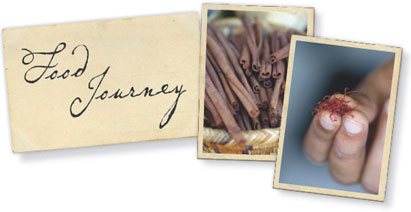

Spice

Arabs were involved in the spice trade for centuries before their foray across North Africa in the late seventh century. Via Moorish Spain, spices were introduced into Morocco, adding to those already used by the Berbers. The spicing skills of Moroccan cooks is the essence of their unique cuisine.
In the spice souks, the ground spices – reds, yellows and all shades of brown – are mounded high and smoothed in baskets, bins, bowls or bags. Whole spices – cassia bark and cinnamon quills, nutmeg, green cardamom pods and liquorice root, tears of mastic and gum arabic, dried chillies and fragrant dried rosebuds – contrast with smooth mounds of ground spices. The eight most important spices for Moroccan cooking are cinnamon, cumin, saffron (sold in small plastic containers to maintain freshness), paprika, turmeric, black pepper, felfla soudaniya (similar to cayenne pepper) and ginger (only dried ginger is used in cooking). Then there are cloves, allspice berries, bay leaves, fenugreek, aniseed, caraway, cumin and coriander seeds.

Tempting as the aromas might be, Moroccan cooks only purchase their spices in small amounts to ensure freshness, taking their purchases home in twisted paper packages to store in pottery jars.
Each spice shop has its own ras el hanout, which translates as ‘top of the shop’, or ‘shopkeeper’s choice’. This ground mixture may contain as many as 26 different spices and dried herbs, depending on the expertise of the shopkeeper. The mix may include black pepper, lavender, thyme, rosemary, ginger, nutmeg, cardamom, cinnamon, fenugreek, cloves and grains of paradise (melegueta pepper). Orris root, cubeb pepper, belladonna, rosebuds, hashish and other ingredients, some not available outside Morocco, might be included, depending, of course, on the shopkeeper.
Of all the spices, saffron reigns supreme, despite being the most expensive spice of all. Some shops offer more than just spices and dried herbs; they stock gnarled roots, berries and certain desiccated wildlife, ground and blended by the apothecary, according to a client’s ailment. Much-loved orange flower and rosewater are also available. However, the amazing spectacle of perfect cones of spices, shaped each day with infinite care, epitomizes the importance of spices in Moroccan cuisine.